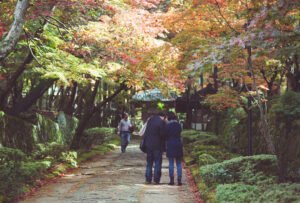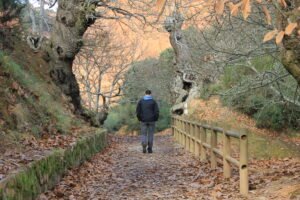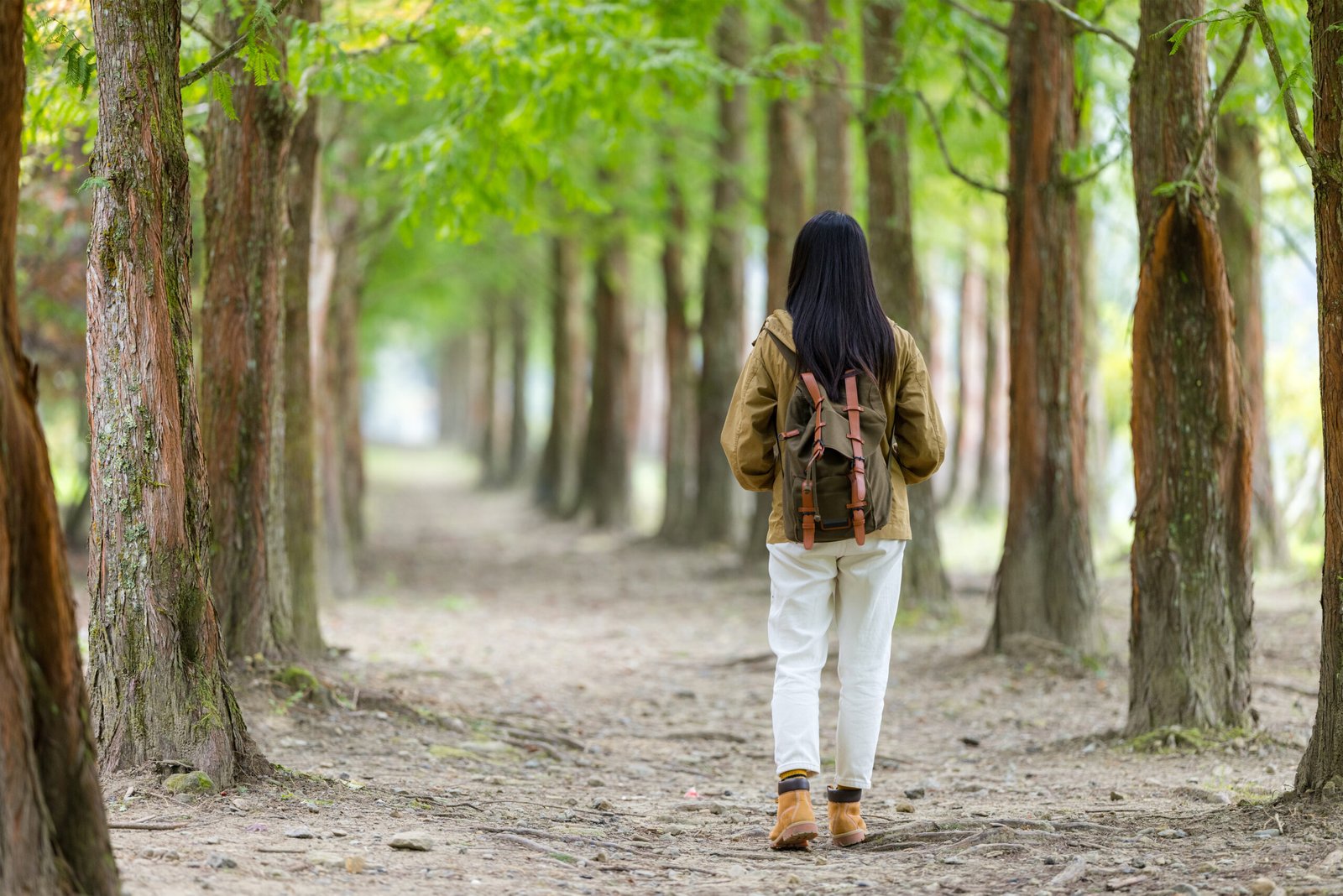The Japanese Art of Forest Walking: How Shinrin-Yoku Is Transforming Global Hiking Culture
Discover the Japanese art of Shinrin-Yoku and how it’s transforming global hiking culture. Learn about its benefits and history.
Imagine swapping traffic noise for birdsong and trading screen glare for dappled sunlight filtering through ancient trees. This is the essence of forest bathing, a practice rooted in Japan’s Shinrin-Yoku tradition. More than a hike, it’s about slowing down to absorb nature’s healing energy through all five senses.
Doctors in Japan have long endorsed this mindful approach to nature. Studies show it lowers stress hormones, boosts immunity, and improves focus. As urban life grows more chaotic, people worldwide are embracing this Japanese art of forest bathing to reconnect with Earth’s rhythms.
You don’t need special gear or training. A quiet walk among trees—noticing textures, scents, and sounds—can work wonders. Dr. Qing Li, a leading researcher, calls forests “natural therapists” that counteract digital overload. Even 20 minutes outdoors sharpens mental clarity.
This guide explores how ancient traditions meet modern science. You’ll learn practical tips to bring forest therapy into daily life, whether you’re near wilderness or city parks. Let’s discover why slowing down might be the fastest way to recharge.
Understanding the Japanese Tradition of Forest Bathing
Amidst Japan’s rapid tech boom in the 1980s, a counter-movement emerged. Government researchers officially launched forest bathing in 1982 as a physiological and psychological health strategy. This wasn’t just a wellness trend—it became woven into Japan’s cultural fabric as an antidote to urban burnout.

Roots in Nature Reverence
Long before its formal naming, the practice drew from Shinto and Buddhist traditions. These philosophies view forests as sacred spaces for renewal. Key elements include:
- Observing seasonal changes in trees
- Mindful breathing techniques among pines
- Using natural light as mood therapy
From Ecotherapy to Global Movement
By the late 20th century, studies proved forest bathing reduced stress hormones by up to 16%. Japanese doctors began prescribing it alongside conventional medicine. The art of forest bathing evolved into:
- Corporate retreats for digital detox
- Guided sensory walks in national parks
- Urban green space initiatives
Today, 64% of Japanese citizens regularly practice this tradition. Its growth mirrors rising global interest in nature-based healing—a bridge between ancient wisdom and modern science.
Cultural Roots and History of Shinrin-Yoku
As neon lights brightened Tokyo’s skyline in the 1980s, doctors noticed a troubling trend. Urban workers showed rising stress levels from tech overload. Japan’s answer? Prescribing walks under forest canopies as official medical advice.
Japanese Ecotherapy and the Digital Detox Movement
Long before smartphones, Shinto traditions taught harmony with nature. Buddhist monks meditated under ancient cedars, believing trees purified the spirit. Modern science now confirms:
- Phytoncides in pine air boost immunity
- 15 minutes among leaves lowers cortisol by 12%
- Natural sounds reset brain wave patterns
| Traditional Practice | Modern Adaptation | Key Benefit |
|---|---|---|
| Seasonal tree rituals | Corporate forest retreats | Reduces screen fatigue |
| Silent mountain pilgrimages | Guided therapy walks | Improves focus |
| Herbal scent therapies | Urban park prescriptions | Lowers blood pressure |
Dr. Qing Li’s research shows city dwellers gain most from forest bathing. His studies reveal improved sleep quality in 78% of participants after three nature sessions. Travel agencies now offer sustainable travel packages pairing hiking trails with mindfulness guides.
From temple gardens to national parks, these experiences help people reconnect. Over 600 certified forest therapy sites now operate worldwide. They prove ancient wisdom still heals modern minds.
Exploring Shinrin-Yoku: Benefits for Mind and Body
What if your daily walk could lower blood pressure and sharpen focus? Research reveals that forest bathing delivers measurable improvements for both body and mind. A 2022 Tokyo Medical University study found participants gained 7% deeper sleep and 9% lower cortisol levels after three nature sessions.
Revitalizing the Body Naturally
Time among trees acts like a natural pharmacy. Phytoncides—chemicals released by evergreens—strengthen immune cells by 40% according to Dr. Qing Li’s research. Gentle activities like mindful hiking trails in parks yield:
- 12% drop in heart rate within 20 minutes
- Improved lung capacity from oxygen-rich air
- Reduced inflammation markers linked to chronic disease
Calming the Modern Mind
Urban stress melts faster in green spaces. Natural light regulates serotonin levels, while rustling leaves create a mindfulness soundtrack. A Kyoto University trial showed:
- 31% faster stress recovery compared to city walks
- Enhanced creativity lasting 48 hours post-walk
- Better decision-making skills in work tasks
Even small doses matter. Boston researchers found office workers near parks reported 22% higher job satisfaction. From Tokyo to New York, therapy centers now blend guided walks with breathing techniques. As Dr. Li notes: “Forests reset our biological rhythms—the ultimate upgrade for modern life.”
Global Impact: Transforming Hiking Culture Worldwide
From Costa Rica’s cloud forests to New York’s Adirondack trails, a quiet revolution reshapes how we walk in nature. The forest bathing movement now spans six continents, blending wellness with environmental care. Travelers swap crowded landmarks for mindful moments under ancient trees.

Nature’s Network Goes Global
Guided art forest experiences thrive beyond Japan. Kenya offers safari walks where elephants trumpets replace phone notifications. Hawaii’s guides teach lava field meditation. These practices share three core values:
- Slow-paced sensory engagement
- Respect for local ecosystems
- Community-led conservation efforts
Rails and Trails: Sustainable Connections
Europe’s rail networks now link cities to forest therapy hubs. Switzerland’s “Slow Travel” passes include guided hikes and carbon-neutral lodging. This shift supports sustainable travel goals while making nature access easier.
| Destination | Unique Feature | Ecological Impact |
|---|---|---|
| Monteverde, CR | Canopy meditation platforms | Funds 12% of rainforest preservation |
| Adirondacks, NY | Maple-scented mindfulness trails | Reduces trail erosion by 18% |
| Scottish Highlands | Whisky barrel forest saunas | Supports deer population control |
Tourism boards report 34% more visitors to protected parks since 2020. Unlike traditional hikes, these curated experiences teach travelers to “listen” to ecosystems. As one Costa Rican guide notes: “We don’t conquer peaks here—we let the forest guide us.”
Practical Insights: How to Experience Forest Bathing
Ready to trade your daily grind for nature’s reset button? Whether you prefer expert-led journeys or quiet solo walks, forest bathing adapts to your pace. Start with these proven methods to unlock nature’s healing power.
Guided Tours and Organized Retreats
Certified guides elevate the experience through sensory exercises. Japan’s Forest Therapy Society offers 62 accredited programs nationwide. Benefits include:
- Structured breathing techniques near waterfalls
- Group tea ceremonies using wild herbs
- Night walks to observe bioluminescent fungi
Booking through platforms like Nature Travel Hub ensures eco-friendly practices. Their 3-day retreats in Nikko National Park report 89% participant satisfaction for stress reduction.
Solo Walks and Mindful Exploration
Prefer solitude? Leave devices behind and let your senses lead. Trails like Yakushima Island’s cedar paths work best for beginners. Key tips:
- Walk 50% slower than usual
- Pause every 10 minutes to name three natural sounds
- Visit at dawn or twilight for minimal crowds
| Feature | Guided Tour | Solo Walk | Best For |
|---|---|---|---|
| Structure | Pre-planned activities | Personal rhythm | First-time explorers |
| Learning | Expert plant ID tips | Self-discovery | Seasoned hikers |
| Cost | $80–$150/day | Free | Budget-conscious |
Balance both approaches: join a guided tour monthly while taking weekly solo walks. This combo deepens your connection to trees while fitting modern schedules. Remember—forest therapy thrives on consistency, not marathon sessions.
Urban Escapes and Natural Sanctuaries for Forest Bathing
Concrete jungles need nature breaks too. Even the busiest cities hide pockets where forest bathing works its magic. From pocket parks to rail-accessible reserves, urban dwellers can recharge without long trips.
Parks and Green Spaces in the City
Tokyo’s Meiji Shrine proves skyscrapers and serenity coexist. Its 170-acre forest absorbs city noise with rustling leaves and trickling streams. Similar oases exist worldwide:
- New York’s Central Park Ramble – 36 acres of winding trails
- London’s Hampstead Heath – ancient woodlands 4 miles from downtown
- Chicago’s Lurie Garden – prairie grasses beside skyscrapers
A 2023 study found 15 minutes in urban green spaces lowers anxiety by 28%. The key? Mindfulness over mileage. Notice moss patterns on benches or sparrow songs over traffic hums.
Hidden Natural Retreats for Quick Rejuvenation
Beyond parks lie lesser-known sanctuaries. Tokyo’s Institute for Nature Study offers wild meadows minutes from Shibuya Station. Near Los Angeles, Griffith Park’s secret fern canyons surprise hikers daily.
| City | Hidden Gem | Travel Time |
|---|---|---|
| San Francisco | Presidio Tunnel Tops | 12 mins by rail |
| Philadelphia | Wissahickon Gorge | 18 mins by subway |
| Boston | Middlesex Fells | 22 mins by commuter rail |
Day trips needn’t be complicated. Portland’s Forest Park spans 5,200 acres—yet trailheads start at bus stops. As one regular visitor notes: “My lunch break forest bathing session beats three espresso shots.”
Final Reflections on Embracing the Art of Forest Walking
As modern life accelerates, forest bathing offers a timeless antidote. Research confirms what Japanese Shinrin-Yoku practitioners knew: immersing in forest environments reduces stress while sharpening focus. Whether wandering state parks or city greenways, this practice helps reclaim balance.
Urban residents can find healing closer to home than they think. Many state-level initiatives now transform vacant lots into micro-forests. Certified guides in places like New York and Portland lead sensory walks, teaching travelers to decode nature’s subtle language.
Your journey needn’t require grand plans. A lunch-break stroll through local woods or weekend trip to forest therapy trails sparks renewal. Studies show even 20 minutes among trees lowers cortisol levels—a sustainable wellness habit for hectic days.
Let this be your invitation. Pack curiosity instead of gear. Listen to rustling leaves like life’s original podcast. As guides often remind us: the forest meets you where you are. Your path to calm begins at the trailhead.




